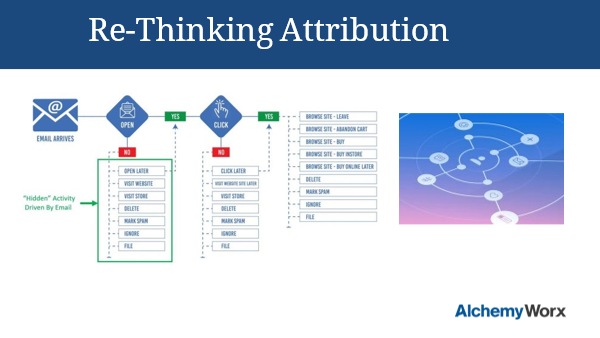Multi-Channel Marketing - Understanding Email’s Contribution to the mix
Many companies struggle with attribution in general, but when it comes email the failure to measuring the true impact of email on their revenue is spectacular! As a result, the email team at most brands face a constant struggle for recognition and more importantly a fair share of available resource.
The reason is most cross or multi-channel attribution models rely on clicks. Whether you decide to attribute the conversion to the first click, the last click or some weighted combination of the 2, you will almost certainly be ignoring email’s incredible ability to drive conversions in other channels without a click or indeed open. What we call the halo effect.

As you can see from the above graphic, not everyone who opens or clicks through from an email will go to the website and make a purchase. In fact, there are many highly valuable actions someone receiving an email can take without either opening or clicking. Worse still none of those actions are likely to be attributed to email.
Clearly, there is value from sending an email that is not being collected when you just focus on opens and clicks. So, how do we measure that?
Th easiest way is to run an analysis of revenue in each channel by day, as a starting point. Then compare revenue of days when you sent more email – 75% or more of your list - with days that you sent less email 25% or less (you could choose 70/30 or 60/40). I would also recommend sticking to weekdays in your initial analysis as they tend to be higher email volume days and will skew your low send days towards weekends.
What you will see will looks something like this. Here the darker bars represent $/channel on days where email is sent to over 75% of the list and the lighter bars represents $/Channel on days when email is sent to fewer often more engaged people.

The results will show email is a major contributor to sales in other channels and in particular highlights the impact email is having on paid channels - affiliate programs, search, and social. In effect you are paying 3rd parties to send back customers you sent to them in the first place. You can STOP that.
The truth is almost nobody is actually employing a truly integrated approach to their messaging. Take search for example. It is the largest and arguably the most expensive digital channel, but have you ever come across a case study or heard of anybody that takes their TV or email activity into account of their bid strategy? In a truly multi-channel world, they would do. By reducing their bids or pausing their programme in the minutes or hours following their ad being aired or email newsletter being deployed, or bidding more when their ads are not on air, or days they don’t send email, because they know exactly how one impacts the other.
Another way to measure emails impact on other channels requires you to analyze purchases or conversions at a subscriber level. This method is of more value to brands with a high paid media spend and is also “relatively” easy to do. Take a list of all converters or purchasers in a given week and see what proportion of them are either new to file (recently acquired), had not been sent an email the previous 30 days vs those purchasers who had received an email. This is similar to an exercise mailchimp conducted a few years back, the results of which can be found here
To accurately measure the effectiveness of email marketing, marketers need to go beyond simple click-based attribution and track and analyze both online and offline traffic and conversions. In doing so, they'll quickly see that the email channel can be harnessed to work with other channels in a similar way to broadcast TV, press or Radio. They will also find it easier to demonstrate the value of email marketing campaigns and allocate resources more efficiently across channels.
 Photo by Eric Prouzet on Unsplash
Photo by Eric Prouzet on Unsplash

 How to resolve AdBlock issue?
How to resolve AdBlock issue? 
 Dela Quist, is CMO of Alchemy Worx, the largest email marketing agency. He is a highly
Dela Quist, is CMO of Alchemy Worx, the largest email marketing agency. He is a highly